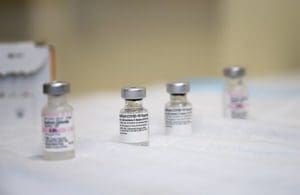
Doses of the COVID-19 vaccine at Walter Reed National Military Medical Center, Bethesda, Md. DoD photo by Lisa Ferdinando.
A case-control study in Israel found no association between recent vaccination with the BNT162b2 vaccine from Pfizer (NYSE:PFE) and BioNtech (NSDQ:BNTX) and facial nerve (Bell’s) palsy. JAMA published the study.
Clinical trials for Pfizer-BioNtech and Moderna COVID-19 vaccines revealed numerical imbalances regarding peripheral facial nerve (Bell’s) palsy. In the former Phase 3 trial, which involved approximately 38,000 patients, four patients in the vaccine group developed Bell’s palsy while none in the placebo group did. FDA concluded in a briefing document that the four cases did not rise above the expected rate in the general population but recommended that health officials monitor mRNA vaccine recipients for Bell’s palsy.
To analyze whether the BNT162b2 vaccine resulted in an elevated risk for peripheral facial nerve palsy, researchers matched patients admitted to an emergency department in central Israel with facial nerve palsy by age, sex and admission date. They then compared patients who had received the BNT16b2 vaccine to those who had not, performing a secondary comparison with the number of patients who developed facial nerve palsy in the past.
Between Jan. 1 to Feb. 28, 2021, a total of 37 patients presented at the hospital with facial nerve palsy. A total of 21 (56.7%) had recently received at least one vaccine dose.
The researchers then matched those 37 patients with 74 controls with the same age, gender and admittance dates. A similar percentage of the control participants (59.5%) had received recent vaccine doses.
The researchers calculated that the adjusted odds ratio for exposure to the BNT162b2 vaccine was 0.84. The unadjusted OR was 0.90.
For context, an odds ratio of 1.0 would mean that exposure to the vaccine does not translate into an elevated risk of Bell’s palsy. Conversely, an odds ratio greater than 1.0 is associated with an elevated risk, while an odds ratio of less than 1.0 would theoretically be associated with reduced risk.
The researchers concluded that seasonality was associated with the development of facial nerve palsy. In the study window, however, hospital admissions for facial nerve palsy in the same period from 2015 to 2020 were similar.
The study authors acknowledged that their study had limitations. Namely, it only focused on recent vaccination with the BNT16b2 vaccine. In addition, they admitted that a secondary analysis comparing patient admittance across multiple years “could be biased by unmeasurable factors such as referral patterns.”
Filed Under: Infectious Disease



